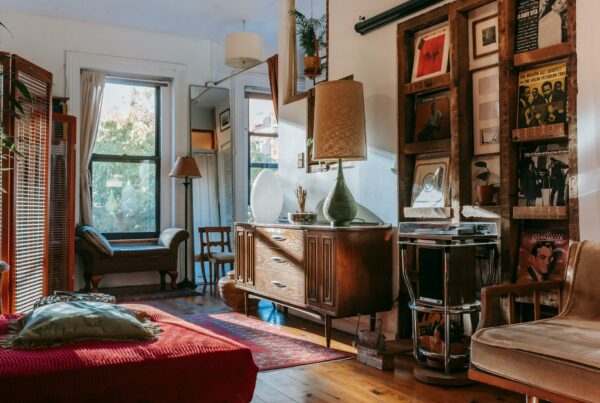Last Updated on October 24, 2023
Getting a good night’s sleep is crucial for both physical and mental health. However, many bedrooms are not optimized for promoting sleep. From decor choices to environmental factors, there are many ways our bedrooms can disrupt sleep without us realizing it.
By making some simple changes, you can turn your bedroom into a sleep haven. Here are 10 must-haves for creating the ideal sleep-friendly bedroom.
1. The Psychology of Color Tones
The colors you choose for your bedroom walls and decor have a significant psychological impact. Cooler tones like blues, greens, and purples have a calming, relaxing effect on the mind and body. These hues lower blood pressure and heart rate, preparing you for rest.
Paint your bedroom walls a soft blue or green. Incorporate bedding, rugs, curtains, and decor accents in these tranquil shades. Avoid warm colors like red, orange, and yellow that can feel too stimulating before bed.
2. The Aromatherapy Advantage
Essential oils can help initiate physiological and mental shifts to prepare for sleep. Lavender and chamomile are ideal before bed because they reduce anxiety and nervousness. The aroma of lavender triggers the release of calming neurotransmitters like serotonin.
Place a few drops of lavender oil on your pillow or sheets. Alternately, use an essential oil diffuser to disperse calming fragrances in your bedroom. Burning candles with relaxing scents like neroli or ylang-ylang can also help you unwind before bed.
3. The Feng Shui Factor: Avoiding Mirrors
In Feng Shui principles, mirrors can negatively impact energy flow and sleep quality when placed in or near the bedroom. Mirrors can create too much activity in an environment and amplify energy. Avoid hanging mirrors directly opposite, next to, or behind the bed. Cover mirrors in your bedroom before sleep for a more restful environment. Nightstand and vanity mirrors are also best removed from Feng Shui sleep-friendly bedrooms.
4. The Importance of Light Elimination
Even small lights from alarm clocks, televisions, smartphones and other electronics can interfere with the release of melatonin and disrupt Circadian rhythms. This impairs your ability to fall and stay asleep.
Use blackout curtains to block outside light pollution. Remove all light-emitting electronics from your bedroom. If needed, use a non-LED alarm
5. Best Pillows
Choosing the right pillow is crucial for getting a good night’s sleep. Different pillow types cater to various sleeping positions and comfort needs. For side sleepers, finding the best pillow is significant. Side sleeping requires a firmer, thicker pillow to support the head, neck, and spine alignment. Otherwise, the pilot can dip down and cause neck strain. The best pillow for side sleepers have gusseted or contoured designs. This provides an elevated surface to fill the space between the head and mattress. Look for pillows explicitly marketed for side sleepers at least 3-5 inches thick.
In contrast, back and stomach sleepers need a flatter, thinner pillow to prevent neck craning or overarching. Side sleepers should avoid too soft or thin pads, which can lead to discomfort. Focus on finding your sleep position’s correct loft, height, and firmness level. The right pad supports keeping your head, neck, and shoulders aligned. Investing in a quality pillow tailored to your sleep habits is crucial for waking up rested and pain-free.
6. The Right Choice of Bedding Material
The breathability and moisture-wicking capabilities of your sheets and blankets affect temperature regulation. Temperature fluctuations as you sleep can negatively impact sleep cycles. Cotton sheets with a 200-400 thread count are ideal for year-round comfort. The natural fibers allow for airflow to control temperature and moisture. Cotton’s soft, breathable texture also feels soothing against skin. Choose blankets of natural materials like cotton, wool, silk or bamboo.
7. The Comfort Equation
An uncomfortable mattress and pillows that don’t correctly support your body put a strain on your spine and muscles. This causes tossing, turning, and interrupted sleep. Invest in a high-quality memory foam or hybrid mattress that cradles your body’s natural curves. Side sleepers need a softer mattress. Back sleepers require a firmer, supportive mattress. Replace flat pillows with ergonomic memory foam pillows that adapt to the neck’s natural positioning.
8. The Ideal Room Temperature
Your body temperature naturally drops at night to initiate sleep. If your bedroom is too warm, it’s harder to reach this lowered core temperature. Studies show ideal sleep occurs between 60-67°F (15- 19°C).
Lower your thermostat to around 65°F (18°C) before bed for optimal sleep. Layer blankets that can be removed instead of relying solely on central heating. If you still feel too warm, use a fan to circulate and cool air.
9. The Clutter-Free Zone
Clutter causes mental stress by overloading your senses. Piles of clothes, books and other items lead to a distracted, busy mind when you should be powering down before bed. A clean space helps create a peaceful headspace.
Declutter nightstands and other bedroom surfaces before sleep each night. Put away any piles of clothes, books, electronics and miscellaneous items. A tidy, clutter-free bedroom promotes mental tranquility for sleep.
10. The Sound of Silence
Noise distractions like traffic, rowdy neighbors or a snoring partner disrupt sleep patterns. Even mild sounds can decrease sleep quality if they repeatedly interrupt the sleep cycle.
Block noise with earplugs, a white noise machine or a sound conditioner. If your partner’s snoring is an issue, try having them use nasal strips or elevate the upper body with extra pillows to improve airflow. Shutting windows and doors can also buffer some noises.
Conclusion
Optimizing your sleep environment is essential for reaping the full restorative benefits of sleep. Follow these 10 tips for creating an oasis that promotes sleeping deeply through the night. Give yourself the gift of a sleep sanctuary that caters to your body’s needs for rest. You’ll wake up feeling truly rested and ready to take on the day.
Frequently Asked Questions
Why do I still have trouble sleeping despite following these tips?
Beyond environmental factors, underlying sleep disorders like insomnia or sleep apnea can impair sleep quality. If poor sleep persists after making your bedroom more sleep-friendly, consult a doctor or sleep specialist for evaluation.
Can I read before bed in my bedroom?
Reading a book before bed in your bedroom is generally fine, especially if it’s done under soft lighting. Light from screens can impair melatonin release, so avoid TVs, smartphones and tablets.
Are expensive bedding and mattresses worth the investment?
Over time, the long-term benefits of quality sleep from proper bedding pays for itself manifold in terms of better health, concentration and productivity. View purchasing upgraded bedding and a new mattress as an investment into your physical and mental well-being.





